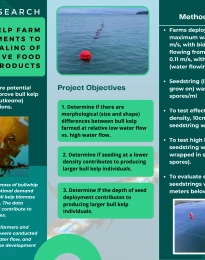Summary
Seaweed farming has the potential to produce feedstocks for many applications, including food, feeds, fertilizers, biostimulants, and biofuels. Seaweeds have advantages over land-based biomass in that they require no freshwater inputs and no allocation of arable land. To date, seaweed farming has not been practiced at scales relevant to meaningful biofuel production. Here we describe a techno-economic model of large-scale seaweed farms and its application to the cultivation of the cool temperate species Saccharina latissima (sugar kelp) and the tropical seaweed Eucheumatopsis isiformis. At farm scales of 1000 ha or more, our model suggests that farm gate production costs in waters up to 200 km from the onshore support base are likely to range between $200 and $300 per dry tonne. The model also suggests that production costs below $100 per dry tonne may be achievable in some settings, which would make these seaweeds economically competitive with land-based biofuel feedstocks. While encouraging, these model results and some assumptions on which they are based require further field validation.



